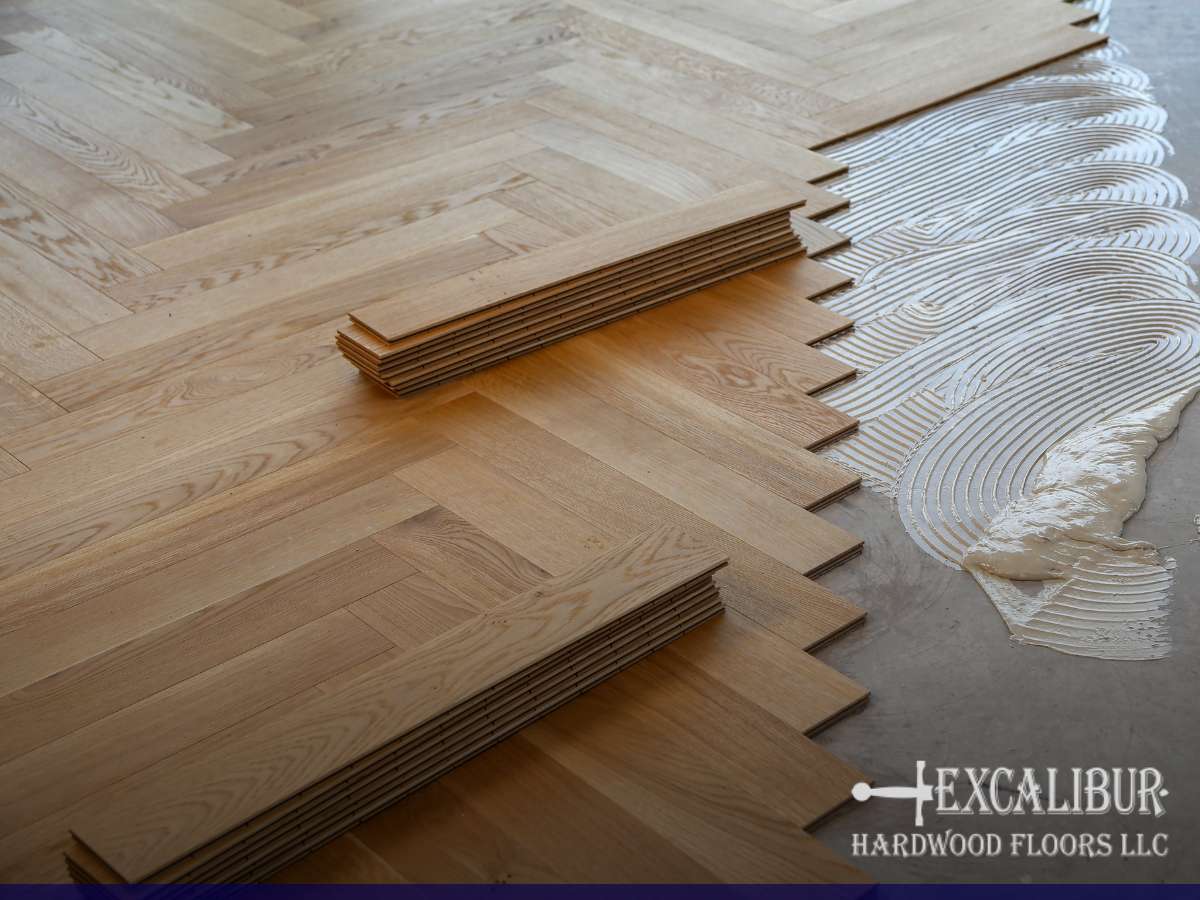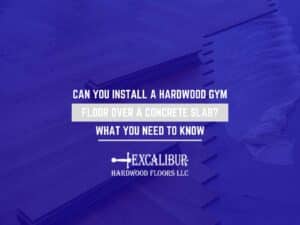Can You Install a Hardwood Gym Floor Over a Concrete Slab? What You Need To Know
Key Factors To Avoid Improper Hardwood Gym Floor Installations
A properly installed hardwood sports floor can transform any gym, basketball court, or athletic facility, improving safety, performance, and durability. But installing hardwood over a concrete slab isn’t as simple as it seems. Without the right subfloor system, moisture protection, and installation technique, even the highest-quality maple sports flooring can warp, buckle, or develop costly issues.
In this guide, we’ll walk you through the key factors every facility manager, coach, and contractor should know before installing a hardwood sports floor over concrete. Helping you avoid mistakes, protect your investment, and ensure a safe, long-lasting athletic surface.

Why Concrete Isn’t as Simple as It Seems
Concrete may seem like a solid foundation, but it presents hidden challenges for indoor athletic surfaces and hardwood sports floor installations. The main problem is moisture, since concrete absorbs and releases it over time while wood reacts to even slight humidity changes. Without proper preparation, this combination can lead to multiple issues, including:
- Moisture trapped beneath the surface.
- Warping, cupping, or buckling of the wood.
- Mold or mildew growth.
- Uneven areas that cause dead spots or poor ball bounce.
- A surface that compromises athlete safety and overall performance.
That’s why experienced hardwood installers always begin by thoroughly testing and preparing the concrete slab before laying down any hardwood. This is essential for creating slip-resistant sports floors and ensuring a stable, dry, and perfectly level foundation for long-term success.
Testing The Concrete Before Installation
Before installing a gym floor, it’s critical to assess the slab’s condition. Three main tests are typically performed:
- Moisture test: ensures the slab is sufficiently dry. Ideally, concrete should cure for at least 60 days before hardwood installation.
- Flatness test: confirms the surface is level within the tolerance specified by gymnasium flooring standards.
- Hardness test: checks that the slab has the proper compression strength, typically between 3,000 and 3,500 PSI.
Skipping these tests can result in premature failure of the floor system, so they’re essential to a successful and long-lasting installation.
The Importance Of a Proper Subfloor System
Even if your concrete slab passes all the tests, you should never install hardwood directly on top of it. A subfloor is essential. It acts as a barrier against moisture, allows for ventilation, and enhances the floor’s overall performance.
A well-designed subfloor system typically includes vapor barriers, resilient pads, and layers of plywood or sleepers. These elements help manage movement and shock absorption, ensuring a stable and durable foundation for hardwood gym floors.
The right subfloor can make a major difference in how a gym floor feels underfoot. It provides energy return, reduces fatigue, and minimizes injury risks for athletes.
The Role Of Maple Hardwood In Sports Facilities
Most sports flooring in gyms, basketball courts, and athletic centers is made from northern hard maple due to its combination of hardness, elasticity, and natural beautyBefore installing a basketball court floor or maple sports flooring, it’s critical to assess the concrete slab’s condition.. Maple offers excellent ball response and superior hardwood floor impact resistance, which is crucial for sports like basketball and volleyball.
Another reason maple is favored is its ability to withstand heavy use without losing its visual appeal. With proper care and refinishing, maple gym floors can maintain their performance and shine for decades.
That’s why professional installers use premium-grade maple and finishes that meet official sports flooring standards, ensuring both performance and longevity.
Moisture Control Tips For Hardwood Gym Floors Over Concrete
Moisture is the number one enemy of hardwood sports floors and other indoor athletic surfaces over concrete. Even minor humidity fluctuations can cause expansion and contraction, leading to gaps or buckling. To avoid this, moisture barriers and ventilation systems must be correctly installed.
Additionally, controlling the indoor environment is key. Maintaining stable humidity and temperature levels helps preserve maple sports flooring durability and prevents long-term structural damage.
If your facility experiences frequent temperature swings, investing in a climate control system is highly recommended to protect your flooring investment.
Common Warning Signs Of Moisture Problems
Even with a proper installation, it’s important to stay vigilant for early signs that moisture may be affecting your hardwood gym floor. Catching these issues early can save you significant repair costs and prevent extensive damage. Some of the most common warning signs include:
- Subtle surface rippling or unevenness: This often happens when moisture causes the wood to expand unevenly. Over time, these minor distortions can worsen, affecting ball bounce and the overall performance of the floor.
- Persistent condensation or damp spots: Recurring water droplets or damp patches often indicate trapped moisture, usually caused by high humidity or inadequate moisture barriers during installation.
- Musty odors: A musty smell is usually a sign of mold or mildew developing under the hardwood. This not only affects the floor’s durability but can also create unhealthy conditions for athletes and facility users.
- Areas where the floor feels soft or “spongy” when stepped on: This symptom indicates that the wood or subflooring has absorbed excess moisture, compromising structural integrity. If ignored, it can lead to significant damage requiring major repairs or replacement.
Recognizing these signs early allows you to address the problem promptly!
Maintenance For Long-Term Performance
Once your hardwood gym floor is properly installed, regular maintenance becomes essential. This includes routine cleaning, screening and recoating every few years, and sanding or refinishing as needed.
Proper maple hardwood maintenance not only preserves appearance but also ensures consistent playability and safety. Dirt, dust, and moisture are the biggest threats to a floor’s finish, so adopting a strict cleaning schedule is crucial.
Professional hardwood floor maintenance services can also assess floor wear patterns and reapply finishes to keep the surface in optimal condition, ensuring your facility always meets performance expectations.
Customization & Aesthetic Appeal For Style & Function
A gym floor is a defining feature of your facility’s look and atmosphere. Modern hardwood installations offer a variety of customization options that not only enhance functionality but also create a unique identity for your space. These options can include:
- Painted logos to showcase team branding.
- Court markings for different sports and events.
- Decorative borders for a polished, professional look.
- Custom color finishes to match your facility’s theme.
The goal is for the floor to be both practical and visually suited to your space, reflecting the style and atmosphere you want to achieve.
Why Professional Installation Matters
While it might be tempting to cut corners or hire general contractors for a gym floor project, this approach often leads to costly mistakes. Installing hardwood over concrete requires specialized expertise in several critical areas, including:
- Subfloor design: Proper knowledge of subfloor systems is essential to ensure stability, moisture control, and optimal performance.
- Adhesives and materials: Choosing the right adhesives and finishes is key to the durability and longevity of the floor.
- Moisture management: Professionals know how to test and treat the slab to prevent moisture-related problems.
Working with a company that specializes in gym floor systems guarantees compliance with industry standards and consistent results. At Excalibur Hardwood Floors, we use only in-house, highly trained employees who ensure quality control from start to finish.
When your project is handled by experts who understand the complexity of shock-absorbing gym floors, you can have confidence that performance, safety, and durability will never be compromised.
Start Your Hardwood Gym Floor Project With Expert Help
If you’re planning to install or refinish your gym’s hardwood floor, there’s no better way to ensure top results and avoid future issues than working with gym floor specialists. At Excalibur Hardwood Floors, we have 20 years of experience delivering outstanding quality and precision in every project.
Want to discuss your project and see how we can help you achieve a flawless gym floor? Just get in touch with us!





